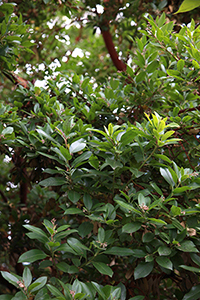Arbutus canariensis

Other common names
Canary Island Strawberry tree, Strawberry tree.
Origin of the species name
Arbutus is Latin for Strawberry tree; canariensis refers to this species naturally occurring on the Canary Islands.
Family
Ericaceae
Date planted
October 2010
Lifespan
Trees of this species are long lived. An Arbutus canariensis growing in Yackandandah Cemetery in Victoria was planted in the 1870s.
General description
This is a small evergreen tree with a smooth trunk. The bark is dark orange in most seasons and it is shed annually. Its leaves are dark green and it can produce large, clusters of white or pale pink bell-like flowers. The knobbly, strawberry-like fruits are orange in colour when ripe. Height 8m Spread 5m.
Natural distribution and habitat
The species occurs naturally on only the Canary Islands where it usually grows in moist soil at 500-1,700m in cloud forest known as laurisilva forest.
Conservation status
It is a threatened species that is endangered by habitat loss on the Canary Islands. The declining water availability and fires may affect some areas where it grows on the islands. Although it is protected in sites like the Garajonay National Park, sections of the park continue to be threatened by deforestation, forest fires, and grazing. An estimated 10,000 trees exist in 10 different locations.
Planting pattern
Planted on the eastern face of Dairy Farmers Hill in a fan pattern so that the rows of trees radiate out as they go down the hill.
Uses
The fruits are edible though gritty in texture.
Further reading
Bramwell D. and Z. Bramwell (2001) Wild Flowers of the Canary Islands(2nd Ed). Rueda, Spain.
Arbutus Tree Story by Susan Parsons.
